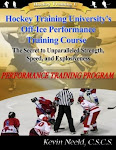
For serious skiers conditioning is an essential part of an overall ski training program. Not only will it allow athletes to perform at a superior level, it's an important preventative measure to protect joints and connective tissue from injury.
From a sporting perspective (as opposed to a leisure activity), skiing events can be broadly grouped into one of five categories:
•Cross country skiing
•Downhill or alpine skiing
•Freestyle skiing
•Nordic combined
•Ski jumping
Snowboarding, while obviously not skiing, is now an Olympic sport and is covered in this section of the website.
Each discipline places their own unique and specific demands on the body; elite freestyle skiers typically having a very different physiological profile compared to cross country skiers for example.
Cross Country Skiing
Elite cross country skiiers rank amongst the top endurance athletes in the world for aerobic power (VO2max). Aerobic capacity as well as onset of blood lactate accumulation can be used to predict success in this group of skiers.
Traditionally, endurance athletes and their coaches have opted for lower intensity and higher volume programs throughout the training year, with as little as 10% of training above the lactate threshold. However, it may be that a reduction in volume and an increase in high quality work can boost performance even in elite-level skiers. Even maximal strength training can improve work economy and overall performance if converted to muscular endurance.
Alpine Skiing
The fitness profiles of alpine skiers differs significantly to their cross country counterparts. A great reliance is placed on anaerobic metabolism - power, power endurance and muscular strength. Even though moderate to high values for aerobic power are recorded in elite downhill skiers, this may be due to their training rather than a direct result of competing. Alpine skiers must be able to react quickly to changes in terrain and the course outline requiring agility, balance and co-ordination.
Downhill skiing forces the athlete into a crouched position placing significant strain on the knees. Not surprisingly, elite skiers have strong legs when measured during isometric and isokinetic leg extensions. Leg strength is also a predictor in downhill and giant slalom events.
Altitude Training
Unquestionably, acclimatization to altitude improves performance at high levels but can altitude training improve an athlete's performance at sea-level?
The research is inconclusive. In theory, some adaptations that take place during prolonged exposure to the hypoxic conditions at 1500 m (4921 ft) or more above sea-level, should improve VO2 max and endurance performance at sea-level. Recall from the acclimatization to altitude article, that staying for a period of time at altitude increases the blood's oxygen carrying capacity.
However, maximal cardiac output is also decreased with exposure to altitude. Along with dehydration and a loss of lean muscle mass these detrimental effects may explain why living and training at altitude does not improve VO2 max or endurance performance on a return to sea-level.
Those few studies that have shown altitude training to have an ergogenic effect on sea-level performance are easy to criticize. Subjects have not usually reached a training peak so it becomes difficult to determine whether increases in aerobic power and / or endurance performance are the result of the adaptations to altitude or intensive training.
The major problem athletes living at altitude face is a significant reduction in training intensity. At 4000 m (13,122 ft) athletes can only exercise at 40% of their sea-level VO2 max compared to 80% at sea-level for example. Breathing hypoxic gases significantly reduces power output and this could lead to substantial detraining negating any of the ergogenic effects associated with acclimatization.























No comments:
Post a Comment